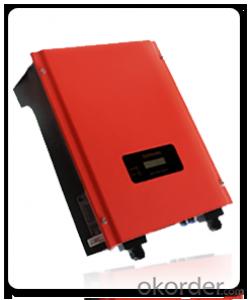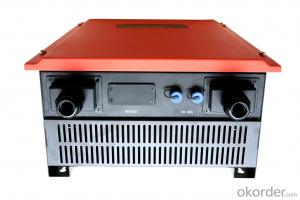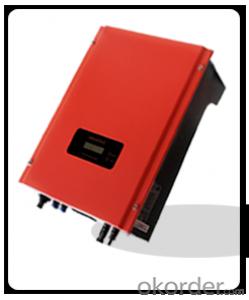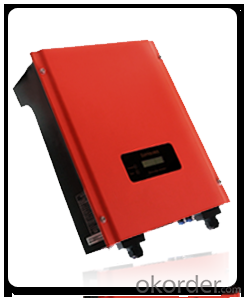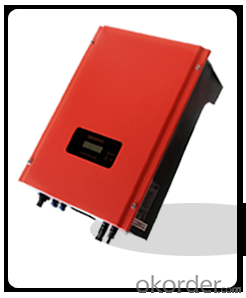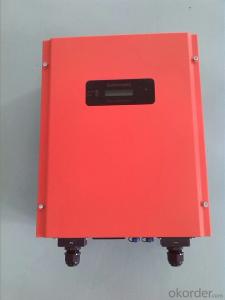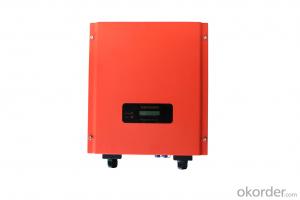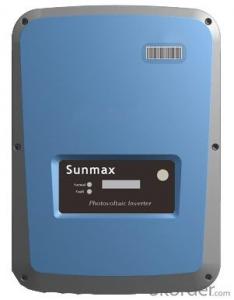Fusion Solar Inverter Sunteams 3600-5000 PV
- Loading Port:
- Shanghai
- Payment Terms:
- TT OR LC
- Min Order Qty:
- 5 watt
- Supply Capability:
- 3000 watt/month
OKorder Service Pledge
OKorder Financial Service
You Might Also Like
The Sunteams 1500 ~5000 series is applicable to various rooftops and small scale photovoltaic grid-connected power plants. Their nominal output powers are 1.5 kW, 2 kW, 2.5 kW,
3 kW, 3.6 kW, 4 kW and 5kW respectively.
This series is transformerless and has a wide range of MPPT input voltage. Its maximum conversion efficiency and MPPT tracking accuracy reach 97.6 % and 99.5 % respectively. The maximum DC voltage reaches 550 V. Its multilingual LCD display facilitates easy operation. It has waterproof direct plug-in terminals. It has overvoltage, islanding, short-circuit, overloading and overheating protection functions. Its IP65 protection degree will ensure it runs well in various tough environments
Efficient
■ The maximum efficiency of the inverter can reach 96.5 % - 97.6 %
■ Transformerless design
Flexible
■ For indoor and outdoor installation
■ Maintenance free
Simple
■ ‘Plug and play’connection for easy installation
■ Designed for hanging with simple and easy installation
Communicative
■ RS232 / RS485 interfaces as standard
■ Optional Bluetooth technology
- Q: What are the potential risks of overloading a solar inverter?
- Overloading a solar inverter can lead to several potential risks. Firstly, it can cause the inverter to overheat, which can result in damage to the internal components and reduce its lifespan. Secondly, overloading can cause the inverter to shut down or trip, interrupting the solar power generation and potentially causing a power outage. Additionally, overloading the inverter may also compromise the safety of the electrical system, increasing the risk of electrical fires or other hazards. Therefore, it is important to ensure that the solar inverter is properly sized and not overloaded to avoid these potential risks.
- Q: What are the safety certifications to look for in a solar inverter?
- When considering a solar inverter, it is important to look for safety certifications such as the UL 1741 standard for grid-tied inverters, which ensures compliance with safety and performance requirements for electrical equipment. Additionally, certifications like IEC 62109 and CSA C22.2 No. 107.1 demonstrate compliance with international safety standards. It is also advisable to check for certifications related to electromagnetic compatibility (EMC) and protection against overvoltage or overcurrent situations.
- Q: Can a solar inverter be used in areas with high levels of electromagnetic interference (EMI)?
- Yes, a solar inverter can be used in areas with high levels of electromagnetic interference (EMI). However, it is important to ensure that the inverter is designed and equipped to handle such conditions. Certain models of solar inverters are specifically designed to mitigate the effects of EMI and provide reliable performance even in challenging electromagnetic environments.
- Q: Can a solar inverter be used with different types of power factor correction devices?
- Yes, a solar inverter can be used with different types of power factor correction devices. Power factor correction devices are designed to improve the power factor of electrical systems and reduce reactive power. Solar inverters convert the DC power generated by solar panels into AC power that can be used in the electrical system. The power factor correction devices can be installed in conjunction with the solar inverter to improve the overall power factor of the system and enhance its efficiency.
- Q: Can a solar inverter be used in systems with multiple solar arrays?
- Yes, a solar inverter can be used in systems with multiple solar arrays. The inverter has the capability to convert the DC power generated by each solar array into AC power that can be used in the electrical system. It can manage and optimize the power output from multiple arrays, ensuring efficient and reliable operation of the overall solar system.
- Q: How do you connect a solar inverter to solar panels?
- To connect a solar inverter to solar panels, you need to follow a few steps. First, ensure that the solar panels are properly installed and positioned to receive maximum sunlight. Then, connect the positive and negative terminals of the solar panels to the corresponding terminals on the solar inverter. Make sure to use appropriate cables and connectors for a secure connection. Once the connections are made, the solar inverter will convert the solar energy generated by the panels into usable electricity for your home or business.
- Q: Can a solar inverter be used with a monitoring system?
- Yes, a solar inverter can be used with a monitoring system. In fact, many solar inverters are equipped with built-in monitoring capabilities, allowing users to track the performance and output of their solar energy system in real-time. Additionally, there are also external monitoring systems available that can be integrated with a solar inverter to provide more advanced monitoring features and data analysis.
- Q: Can a solar inverter be used with solar-powered electric vehicle charging stations?
- Yes, a solar inverter can be used with solar-powered electric vehicle charging stations. A solar inverter is necessary to convert the DC (direct current) power generated by solar panels into AC (alternating current) power that can be used by electric vehicle charging stations. This allows the solar power to be fed into the charging station and used to charge electric vehicles.
- Q: Can a solar inverter be used with different types of energy storage systems?
- Yes, a solar inverter can be used with different types of energy storage systems. Solar inverters are designed to convert the direct current (DC) generated by solar panels into alternating current (AC) that can be used to power electrical devices. The AC output from the solar inverter can be connected to various energy storage systems, such as batteries, to store excess energy generated by the solar panels for later use. Therefore, solar inverters are compatible with different types of energy storage systems, allowing for efficient utilization of solar energy.
- Q: Can a solar inverter be used with a solar-powered cooling system?
- Yes, a solar inverter can be used with a solar-powered cooling system. A solar inverter is responsible for converting the direct current (DC) electricity generated by solar panels into alternating current (AC) electricity that can be used to power various appliances, including cooling systems. By integrating a solar inverter into a solar-powered cooling system, the system can effectively harness solar energy to operate and provide cooling without relying on external power sources.
Send your message to us
Fusion Solar Inverter Sunteams 3600-5000 PV
- Loading Port:
- Shanghai
- Payment Terms:
- TT OR LC
- Min Order Qty:
- 5 watt
- Supply Capability:
- 3000 watt/month
OKorder Service Pledge
OKorder Financial Service
Similar products
Hot products
Hot Searches
Related keywords
